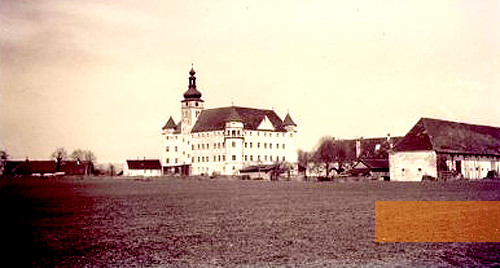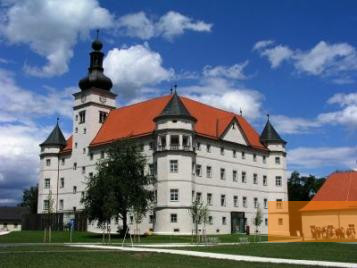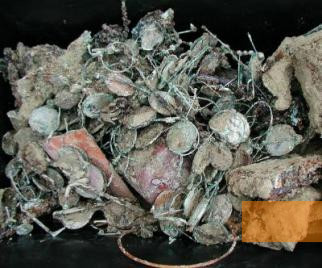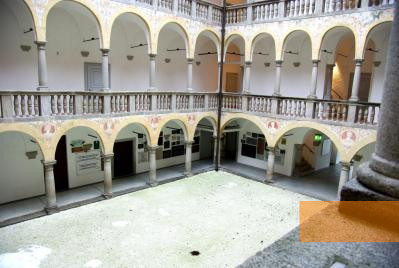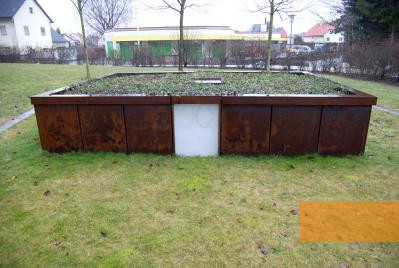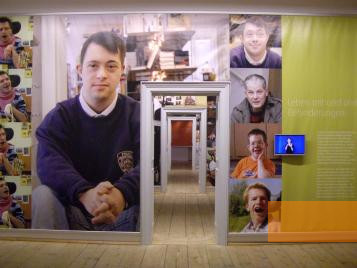Hartheim Castle, a castle situated in Alkoven in Upper Austria, functioned as a »euthanasia killing centre« from early 1940 onwards. Around 30,000 people were murdered there in gas chambers between 1940 and 1944. In 1969, memorial rooms to the victims were set up in the castle. The »Hartheim Castle - Place of Learning and Remembrance« was opened in 2004.
Until 1938, Hartheim Castle housed a nursing home for up to 200 mentally and physically handicapped people. In 1939, the owner - the Upper Austrian State Benevolent Society - had to yield the institution to the National Socialist authorities. In the spring of 1940, a »euthanasia killing centre« was set up there, as part of the so-called »Action T4«. The aim of this campaign, which was centrally organised in Berlin, was to kill mentally handicapped people.
The killings in Hartheim as part of the »Action T4« began in May 1940. Under the guidance of Dr. Rudolf Lonauer, a psychiatrist from Linz, the doctors, nursing personnel, police officers and members of the SS contributed to the murder of »life unworthy of life«. Among the first victims were patients of the psychiatric hospital which had been located in the castle until 1938. From May 1940, staff members of T4 transported thousands of patients from psychiatric hospitals in Austria and Bavaria to Hartheim. In all, approximately 18,200 people were asphyxiated with carbon monoxide in the centre's gas chamber. In August 1941, the National Socialist leadership ordered a halt to the operation, partly due to public protests of churches and families of the victims. The killings in Hartheim continued, however: at least 8,000 prisoners deemed incapable of working from the concentration camps at Dachau, Mauthausen and Gusen were murdered in Hartheim (»Aktion 14f13«). In a further »Aktion«, the personnel of the centre murdered forced labourers from Eastern Europe who were considered to be incapable of working.
In 1944/1945, towards the end of the war, the extermination facilities in Hartheim were dismantled and traces of the murders destroyed.
The killings in Hartheim as part of the »Action T4« began in May 1940. Under the guidance of Dr. Rudolf Lonauer, a psychiatrist from Linz, the doctors, nursing personnel, police officers and members of the SS contributed to the murder of »life unworthy of life«. Among the first victims were patients of the psychiatric hospital which had been located in the castle until 1938. From May 1940, staff members of T4 transported thousands of patients from psychiatric hospitals in Austria and Bavaria to Hartheim. In all, approximately 18,200 people were asphyxiated with carbon monoxide in the centre's gas chamber. In August 1941, the National Socialist leadership ordered a halt to the operation, partly due to public protests of churches and families of the victims. The killings in Hartheim continued, however: at least 8,000 prisoners deemed incapable of working from the concentration camps at Dachau, Mauthausen and Gusen were murdered in Hartheim (»Aktion 14f13«). In a further »Aktion«, the personnel of the centre murdered forced labourers from Eastern Europe who were considered to be incapable of working.
In 1944/1945, towards the end of the war, the extermination facilities in Hartheim were dismantled and traces of the murders destroyed.
Between May 1940 and August 1941, more than 18,200 patients from psychiatric hospitals were murdered at Hartheim Castle, as part of the »Action T4«. Between 1941 and 1944, an additional 8,000 to 10,000 prisoners from the concentration camps at Dachau, Mauthausen and Gusen, as well as forced labourers from Eastern Europe deemed »incapable of working« were murdered by personnel of the killing centre.
Already in July 1945, shortly after the end of the war, the »US War Crimes Investigation Team« interviewed perpetrators and witnesses of the murders in Hartheim. In addition, the so-called Hartheim statistics were found, in which the parties involved had documented the murders.
After 1945, Hartheim Castle was returned to the Upper Austrian State Benevolent Society. In 1969, it established memorial rooms in the former reception room and the gas chamber. In 1995, the Hartheim Castle Association was founded. In 1997, upon initiative of the Association, the State of Upper Austria decided to renovate the castle and redesign it as an education and memorial centre on the topic of National Socialist »euthanasia« and its victims. In 2003, the »Hartheim Castle - Place of Learning and Remembrance« was opened with an exhibition entitled »The Value of Life«, which thematises the way in which societies have dealt with handicapped people from the beginning of industrialisation in the late 18th century until today.
After 1945, Hartheim Castle was returned to the Upper Austrian State Benevolent Society. In 1969, it established memorial rooms in the former reception room and the gas chamber. In 1995, the Hartheim Castle Association was founded. In 1997, upon initiative of the Association, the State of Upper Austria decided to renovate the castle and redesign it as an education and memorial centre on the topic of National Socialist »euthanasia« and its victims. In 2003, the »Hartheim Castle - Place of Learning and Remembrance« was opened with an exhibition entitled »The Value of Life«, which thematises the way in which societies have dealt with handicapped people from the beginning of industrialisation in the late 18th century until today.
- Name
- Lern- und Gedenkort Schloss Hartheim
- Address
-
Schlossstraße 1
4072 Alkoven - Phone
- +43 (0)7274 653 654 6
- Web
- http://www.schloss-hartheim.at
- office@schloss-hartheim.at
- Open
- Monday to Friday: 9.00 a.m. to 3.00 p.m., Tuesday to Thursday: 9.00 a.m. to 4.00 p.m., Sundays and holidays: 10.00 a.m. to 5.00 p.m., closed on Saturdays
- Possibilities
- Permanent exhibition with guided tours for school groups, temporary exhibitions, library, archive, documentation centre of the Upper Austrian provincial archive


